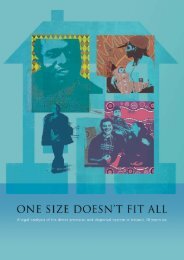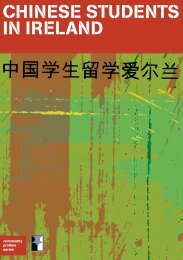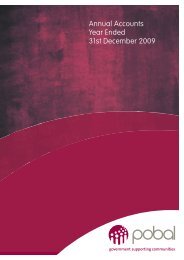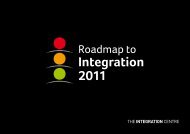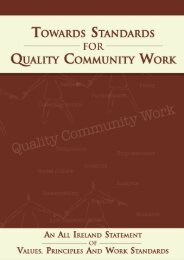Intercultural Education in the Post-Primary School - National Council ...
Intercultural Education in the Post-Primary School - National Council ...
Intercultural Education in the Post-Primary School - National Council ...
You also want an ePaper? Increase the reach of your titles
YUMPU automatically turns print PDFs into web optimized ePapers that Google loves.
Portfolio assessmentMany writers on <strong>the</strong> education ofl<strong>in</strong>guistically and culturally diversestudents recommend portfolio assessmentas a more equitable way of ga<strong>the</strong>r<strong>in</strong>g<strong>in</strong>formation about students’ learn<strong>in</strong>g.(Trumbull and Farr, 1996; Genesee andHamayan, 1994: Freeman and Freeman,1991).What is a portfolio?A portfolio is a collection of work thatshows an <strong>in</strong>dividual’s efforts, progress orachievements over an extended period oftime. The development of a portfolio<strong>in</strong>volves documentation of achievements,self-evaluations and reflections on learn<strong>in</strong>gcollected over a period of time. The use ofportfolios is an effective method ofassessment that can provide newcomerstudents with a positive record ofachievement and progress made.The portfolio is not simply a collection ofsamples of work; it is a record of progressand achievement. It is important that <strong>the</strong>portfolio <strong>in</strong>cludes more than one <strong>in</strong>dicatorof achievement and can enable a widerange of knowledge, skills and attitudes tobe recorded. Several entries should reflectdifferent learn<strong>in</strong>g styles and key learn<strong>in</strong>gexperiences, for example, key experiments,worksheets, essay answers, researchprojects, video record<strong>in</strong>gs or audiopresentations /<strong>in</strong>terviews, reflective writ<strong>in</strong>g/journal work, etc. It should also <strong>in</strong>clude<strong>the</strong> use of a learn<strong>in</strong>g log, record<strong>in</strong>g <strong>the</strong>student’s own observations and those of<strong>the</strong> teacher. Student’s choice <strong>in</strong> <strong>the</strong> selectionof work is also important. Themanagement of <strong>the</strong> portfolio can besupported by <strong>the</strong> language support teacher,where appropriate.The teacher’s role is to• expla<strong>in</strong> <strong>the</strong> purpose of <strong>the</strong> portfolio• focus <strong>the</strong> student’s learn<strong>in</strong>g on <strong>the</strong>process of mak<strong>in</strong>g <strong>the</strong> portfolio ra<strong>the</strong>rthan on <strong>the</strong> mechanics• agree <strong>the</strong> criteria for <strong>the</strong> selection andcollection of materials• advise students regard<strong>in</strong>g self-evaluationand reflective statement• agree expectations and criteria to beused <strong>in</strong> <strong>the</strong> assessment of <strong>the</strong> portfolios• keep <strong>the</strong> portfolios simple to beg<strong>in</strong> withand allow <strong>the</strong>m to become moresophisticated• help develop a management system.98<strong>Intercultural</strong> <strong>Education</strong> <strong>in</strong> <strong>the</strong> <strong>Post</strong>-<strong>Primary</strong> <strong>School</strong>








